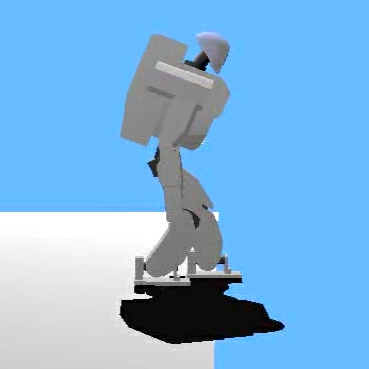Biorobotics Laboratory BioRob
Julien Nicolas (Diploma Project 2005)
Supervisors: Ludovic Righetti and Auke Ijspeert
Artificial evolution of controllers based on non-linear oscillators for bipedal locomotion
Millions of years of evolution made humans able to walk and run with an incredible precision. Although bipedal locomotion could seem to be a simple mechanical problem, researches done on artificial locomotion proved that it is far from obvious to generate a walking gait that is as fast and stable as humans do.
This work is directly inspired from biological considerations by using CPG based controllers and artificial evolution. First, several models of CPGs, implemented on a simulated robot, were explored using genetic algorithms to find which system is best suited to locomotion. After that, our model was improved by adding feedback pathways in the CPGs in order to be able to modify the speed of locomotion.
The approach described above allowed us to make the robot walk at approximatively 0.28 m/s without feedback. We also managed to increase the system's frequency by adding feedback pathways which allowed us to increase the velocity by 25% (0.37 m/s). Unfortunately, the model found was not really robust against external perturbations.
Videos
Videos of the simulation with different oscillator models (the video goes faster than the real simulation)
Hopf

hopf.avi Model based on Hopf oscillators (without feedback)
Matsuoka

matsuoka.mpeg Model based on Matsuoka oscillators (without feedback)
matsuoka_fb.mpeg Model based on Matsuoka oscillators (with feedback)
- Archived student projects
- Alain Dysli
- Alexandre Tuleu
- Anurag Tripathi
- Ariane Pasquier
- Aïsha Hitz
- Barthélémy von Haller
- Benjamin Fankhauser
- Benoit Rat
- Bertrand Mesot
- Biljana Petreska
- Brian Jimenez
- Christian Lathion
- Christophe Richon
- Cédric Favre
- Daisy Lachat
- Daniel Marbach
- Daniel Marbach
- Elia Palme
- Elmar Dittrich
- Etienne Dysli
- Fabrizio Patuzzo
- Fritz Menzer
- Giorgio Brambilla
- Ivan Kviatkevitch
- Jean-Christophe Fillion-Robin
- Jean-Philippe Egger
- Jennifer Meinen
- Jesse van den Kieboom
- Jocelyne Lotfi
- Julia Jesse
- Julien Gagnet
- Julien Nicolas
- Julien Ruffin
- Jérôme Braure
- Jérôme Guerra
- Jérôme Maye
- Jérôme Maye
- Kevin Drapel & Cyril Jaquier
- Kevin Drapel & Cyril Jaquier
- Loïc Matthey
- Ludovic Righetti
- Lukas Benda
- Lukas Hohl
- Lukas Hohl
- Marc-Antoine Nüssli
- Martin Biehl
- Martin Riess
- Martin Rumo
- Mathieu Salzmann
- Matteo Thomas de Giacomi
- Matteo Thomas de Giacomi
- Michael Gerber
- Michel Ganguin
- Michel Yerly
- Mikaël Mayer
- Muhamed Mehmedinovic
- Neha Priyadarshini Garg
- Nicolas Delieutraz
- Panteleimon Zotos
- Pascal Cominoli
- Pascal Cominoli
- Patrick Amstutz
- Pedro Lopez Estepa
- Pierre-Arnaud Guyot
- Rafael Arco Arredondo
- Raphaël Haberer-Proust
- Rico Möckel
- Sacha Contantinescu
- Sandra Wieser
- Sarah Marthe
- Simon Blanchoud
- Simon Capern
- Simon Lépine
- Simon Ruffieux
- Simon Rutishauser
- Stephan Singh
- Stéphane Mojon
- Stéphane Mojon
- Sébastian Gay
- Vlad Trifa
- Yvan Bourquin
